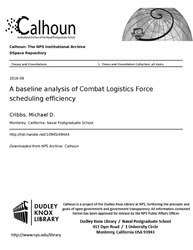File:A baseline analysis of Combat Logistics Force scheduling efficiency (IA abaselinenalysis1094549444).pdf

Original file (1,275 × 1,650 pixels, file size: 2.52 MB, MIME type: application/pdf, 76 pages)
Captions
Captions
Summary[edit]
| A baseline analysis of Combat Logistics Force scheduling efficiency
( |
||
|---|---|---|
| Author |
Cribbs, Michael D. |
|
| Title |
A baseline analysis of Combat Logistics Force scheduling efficiency |
|
| Publisher |
Monterey, California: Naval Postgraduate School |
|
| Description |
Combatant ships in the Fifth Fleet sphere of operations depend upon Military Sealift Command (MSC) to supply stores and fuel while they are underway. Scheduling the delivery of supplies has predominately been customer driven, which has led to inefficiencies in the utilization of MSC resources. The introduction of Replenishment at Sea Planner (RASP) in 2013 provided a new tool that is expected to increase efficiency of scheduling operations by reducing scheduling errors and manpower needed for fulfillment. The purpose of this research is to analyze data from Fifth Fleet collected before and after RASP with a goal of establishing a baseline efficiency in Combat Logistics Force (CLF) ship utilization. Supply and demand models were built over the data sets, presenting an interesting view of the disproportion of available commodity available to customers. Efficiencies were compared before and after RASP, resulting in a recommendation that the Fast Combat Support Ship (AOE) be the ship of choice due to better efficiency and cost to deliver commodity to the warship in the Fifth Fleet area of responsibility. The trends from the data were mostly inconclusive, however; as a result, this paper recommends expanding the research years for further data analysis to include 2011, 2012, 2014, and 2016. Subjects: logistics; Military Sealift Command; efficiency; freight rates; Combat Logistics Force; replenishment at sea; replenishment at sea planner; coalition support; supply and demand |
|
| Language | English | |
| Publication date | June 2016 | |
| Current location |
IA Collections: navalpostgraduateschoollibrary; fedlink |
|
| Accession number |
abaselinenalysis1094549444 |
|
| Source | ||
| Permission (Reusing this file) |
This publication is a work of the U.S. Government as defined in Title 17, United States Code, Section 101. Copyright protection is not available for this work in the United States. | |
Licensing[edit]
| Public domainPublic domainfalsefalse |
This work is in the public domain in the United States because it is a work prepared by an officer or employee of the United States Government as part of that person’s official duties under the terms of Title 17, Chapter 1, Section 105 of the US Code.
Note: This only applies to original works of the Federal Government and not to the work of any individual U.S. state, territory, commonwealth, county, municipality, or any other subdivision. This template also does not apply to postage stamp designs published by the United States Postal Service since 1978. (See § 313.6(C)(1) of Compendium of U.S. Copyright Office Practices). It also does not apply to certain US coins; see The US Mint Terms of Use.
|
 | |
| This file has been identified as being free of known restrictions under copyright law, including all related and neighboring rights. | ||
https://creativecommons.org/publicdomain/mark/1.0/PDMCreative Commons Public Domain Mark 1.0falsefalse
File history
Click on a date/time to view the file as it appeared at that time.
| Date/Time | Thumbnail | Dimensions | User | Comment | |
|---|---|---|---|---|---|
| current | 19:50, 13 July 2020 |  | 1,275 × 1,650, 76 pages (2.52 MB) | Fæ (talk | contribs) | FEDLINK - United States Federal Collection abaselinenalysis1094549444 (User talk:Fæ/IA books#Fork8) (batch 1993-2020 #5008) |
You cannot overwrite this file.
File usage on Commons
The following page uses this file:
Metadata
This file contains additional information such as Exif metadata which may have been added by the digital camera, scanner, or software program used to create or digitize it. If the file has been modified from its original state, some details such as the timestamp may not fully reflect those of the original file. The timestamp is only as accurate as the clock in the camera, and it may be completely wrong.
| Short title |
|
|---|---|
| Author | sjhawtho |
| Date and time of digitizing | 04:42, 3 June 2016 |
| Software used | PScript5.dll Version 5.2.2 |
| File change date and time | 08:05, 6 July 2016 |
| Date metadata was last modified | 08:05, 6 July 2016 |
| Conversion program | Acrobat Distiller 11.0 (Windows) |
| Encrypted | no |
| Page size | 612 x 792 pts (letter) |
| Version of PDF format | 1.4 |

